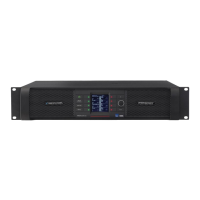25
5.4.1. Low Inrush Current
High power ampliers with inadequate inrush current limiting can draw considerable current from the mains at
turn–on, sometimes tripping a fast–acting mains breaker. The PLM+, however, has very low inrush current to
prevent tripping of breakers. Several units can, under normal conditions, be powered up simultaneously. If you
do experience problems powering up multiple units simultaneously, they must either be turned on manually in an
ordered manner, or sequenced remotely using the Lake Controller software’s Global Control feature. Alternatively,
the capacity of the mains supply should be increased.
NOTE: If insufcient power is available to allow simultaneous power–up, then there is probably
insufcient capacity for full power output during operation. It is recommended that additional capacity is
added to the mains power distribution system.
5.5. LoadPilot Load Monitoring
5.5.1. Introduction
LoadPilot is a feature in PLM+ ampliers that can continually monitor the integrity of loudspeakers and cables
connected to the outputs to ensure that they are functioning properly and free from major anomalies or faults.
By implementing LoadPilot, systems incorporating PLM+ ampliers can be certied in compliance with voice
evacuation standards such as EN54–16 and NFPA72.
LoadPilot functions by automatically superimposing low–level pilot tones on the input signal (if any present) to the
amplier. One tone is below the range of human hearing (approximately 10–20 Hz) and the other above (24 kHz),
so the activity of LoadPilot is inaudible regardless of whether the system is currently reproducing program content.
High–resolution current sensing on the outputs can calculate the impedance of the load at the frequency of the
tones. Hence a stable measurement of the impedance of the load can be obtained and potential anomalies or
faults can be detected that would indicate impaired loudspeaker function or total inoperability due to failure of the
loudspeaker or faults in connected wiring. The superimposition of pilot tones and analysis is interleaved across the
amplier’s output channels with a maximum total cycle time of around 20 seconds.
LoadPilot is implemented and congured in the CAFÉ software. Monitoring status and fault indication are displayed
on the front panel and both in CAFÉ and Lake Controller.
LoadPilot may be congured with the automatic calibration or through a manual advanced mode, depending on
monitoring requirements and characteristics of the connected loudspeaker loads.
5.5.2. Automatic calibration
5.5.2.1 Functional description
Automatic calibration is suitable for the following applications and requirements for error detection:
• If one or two low–impedance loudspeakers are connected; if two in parallel is default, it will warn if one is
missing.

